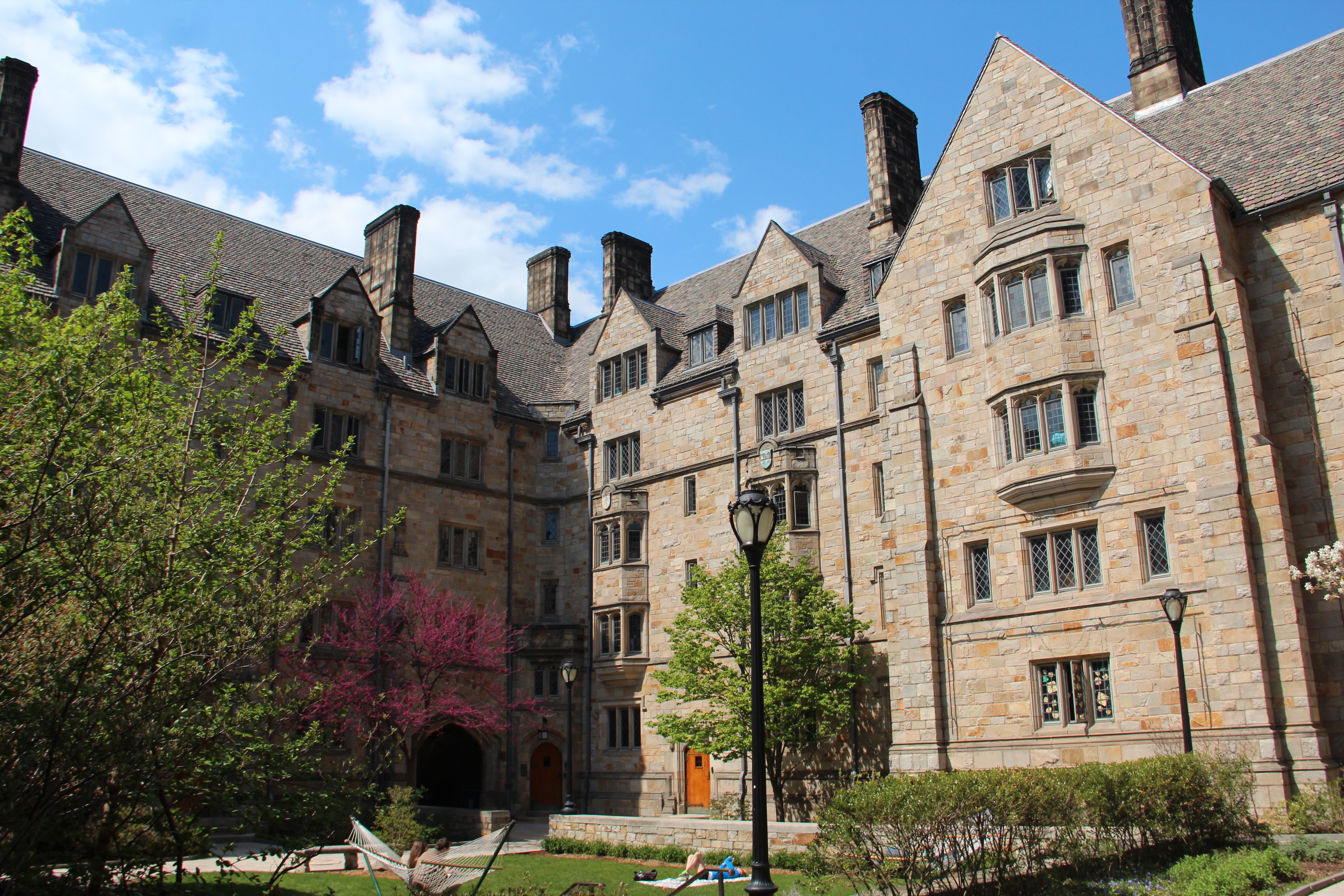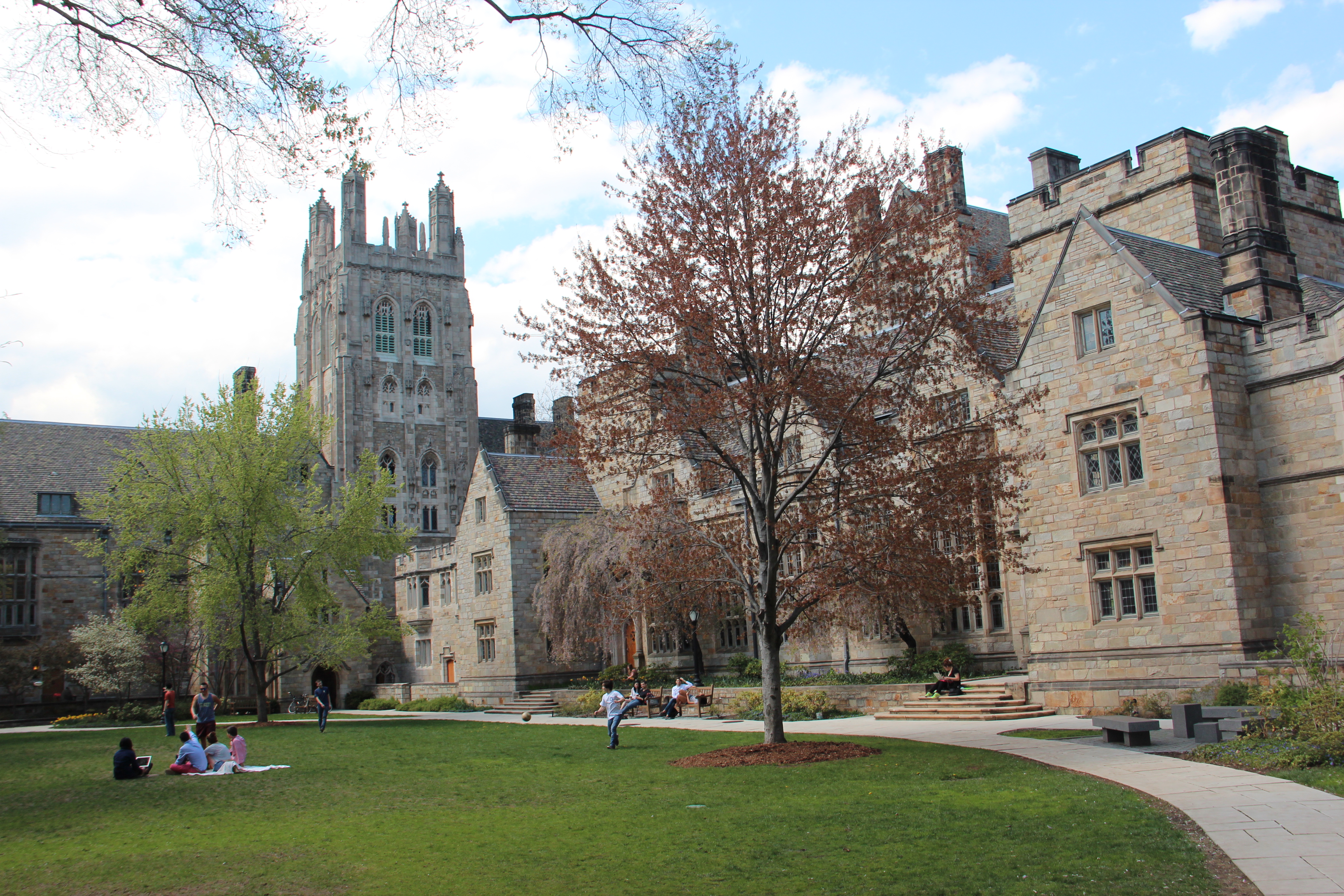Memorial Quadrangle on:
[Wikipedia]
[Google]
[Amazon]
 The Memorial Quadrangle is a residential quadrangle at
The Memorial Quadrangle is a residential quadrangle at
 Construction began in 1917, the bicentennial of Yale's first building in New Haven, and was completed in 1921. As initially built, the Quadrangle contained dorm rooms for 630 students, a dining hall, and seven courtyards. Dry moats with low walls, a frequent architectural motif at Yale, were first used by this building and were planted with
Construction began in 1917, the bicentennial of Yale's first building in New Haven, and was completed in 1921. As initially built, the Quadrangle contained dorm rooms for 630 students, a dining hall, and seven courtyards. Dry moats with low walls, a frequent architectural motif at Yale, were first used by this building and were planted with
 From 1921 to 1929 the building housed Yale College seniors. In 1928, a donation from
From 1921 to 1929 the building housed Yale College seniors. In 1928, a donation from
 The Memorial Quadrangle is a residential quadrangle at
The Memorial Quadrangle is a residential quadrangle at Yale University
Yale University is a private research university in New Haven, Connecticut. Established in 1701 as the Collegiate School, it is the third-oldest institution of higher education in the United States and among the most prestigious in the wo ...
in New Haven, Connecticut
New Haven is a city in the U.S. state of Connecticut. It is located on New Haven Harbor on the northern shore of Long Island Sound in New Haven County, Connecticut and is part of the New York City metropolitan area. With a population of 134,02 ...
. Commissioned in 1917 to supply much-needed student housing for Yale College
Yale College is the undergraduate college of Yale University. Founded in 1701, it is the original school of the university. Although other Yale schools were founded as early as 1810, all of Yale was officially known as Yale College until 1887, ...
, it was Yale's first Collegiate Gothic building and its first project by James Gamble Rogers, who later designed ten other major buildings for the university. The Quadrangle has been occupied by Saybrook College
Saybrook College is one of the 14 residential colleges at Yale University. It was founded in 1933 by partitioning the Memorial Quadrangle into two parts: Saybrook and Branford.
Unlike many of Yale's residential colleges that are centered on one ...
and Branford College
Branford College is one of the 14 residential colleges at Yale University.
Founding
Branford College was founded in 1933 by partitioning the Memorial Quadrangle (built in 1917-21) into two parts: Saybrook and Branford. According to Robert Frost ...
, two of the original ten residential colleges at Yale. The collegiate system of Yale University
Yale University is a private research university in New Haven, Connecticut. Established in 1701 as the Collegiate School, it is the third-oldest institution of higher education in the United States and among the most prestigious in the wo ...
was largely inspired by the Oxbridge
Oxbridge is a portmanteau of Oxford and Cambridge, the two oldest, wealthiest, and most famous universities in the United Kingdom. The term is used to refer to them collectively, in contrast to other British universities, and more broadly to de ...
model of residential and teaching colleges at the University of Oxford
, mottoeng = The Lord is my light
, established =
, endowment = £6.1 billion (including colleges) (2019)
, budget = £2.145 billion (2019–20)
, chancellor ...
and the University of Cambridge
, mottoeng = Literal: From here, light and sacred draughts.
Non literal: From this place, we gain enlightenment and precious knowledge.
, established =
, other_name = The Chancellor, Masters and Schola ...
in the UK.
The building was donated by Anna M. Harkness
Anna Maria Richardson Harkness (October 25, 1837 – March 27, 1926) was an American philanthropist.
Early life
She was born on October 25, 1837, in Dalton, Ohio, and was the daughter of James Richardson and Anna ( née Ranck) Richardson. Not m ...
to memorialize her son, Yale College graduate Charles W. Harkness, who died in 1916. Charles' brother, Edward Harkness
Edward Stephen Harkness (January 22, 1874 – January 29, 1940) was an American philanthropist. Given privately and through his family's Commonwealth Fund, Harkness' gifts to private hospitals, art museums, and educational institutions in the Nort ...
, became the primary benefactor of Yale's residential college system fifteen years later, a scheme which required a partial reconfiguration of the Memorial Quadrangle to create its two residential colleges. Harkness Tower
Harkness Tower is a masonry tower at Yale University in New Haven, Connecticut. Part of the Collegiate Gothic Memorial Quadrangle complex completed in 1922, it is named for Charles William Harkness, brother of Yale's largest benefactor, Edward ...
, a large masonry tower on the building's west side, was named in memory of Charles Harkness, a memorial to whom is found in the tower's chapel.
Building
ivy
''Hedera'', commonly called ivy (plural ivies), is a genus of 12–15 species of evergreen climbing or ground-creeping woody plants in the family Araliaceae, native to western, central and southern Europe, Macaronesia, northwestern Africa and ...
, flowers, and trees by landscape architect Beatrix Jones Farrand
Beatrix Cadwalader Farrand (née Jones; June 19, 1872 – February 28, 1959) was an American landscape gardener and landscape architect. Her career included commissions to design about 110 gardens for private residences, estates and country ho ...
with an eye to both increased privacy and street beautification.
Harkness Tower
Harkness Tower is a masonry tower at Yale University in New Haven, Connecticut. Part of the Collegiate Gothic Memorial Quadrangle complex completed in 1922, it is named for Charles William Harkness, brother of Yale's largest benefactor, Edward ...
, the most visible symbol of Yale on the New Haven
New Haven is a city in the U.S. state of Connecticut. It is located on New Haven Harbor on the northern shore of Long Island Sound in New Haven County, Connecticut and is part of the New York City metropolitan area. With a population of 134,02 ...
skyscape, is placed on an axis unifying it with Yale's Old Campus
The Old Campus is the oldest area of the Yale University campus in New Haven, Connecticut. It is the principal residence of Yale College freshmen and also contains offices for the academic departments of Classics, English, History, Comparative Li ...
.
The building is divided into seven courtyards, which Rogers framed with materials and decorative elements giving each distinct character. Three—Killingworth Court, Saybrook Court, and the largest, Branford Court—commemorate Connecticut towns significant to the school's founding, and a fourth, Wrexham Court, the resting place of Elihu Yale
Elihu Yale (5 April 1649 – 8 July 1721) was a British-American colonial administrator and philanthropist. Although born in Boston, Massachusetts, he only lived in America as a child, spending the rest of his life in England, Wales and India ...
. The other three, on the building's southern side and now part of Branford College, are named for early debating societies in Yale College: Brothers in Unity
Brothers in Unity (formally, the Society of Brothers in Unity) is an undergraduate society at Yale University. Founded in 1768 as a literary and debating society that encompassed nearly half the student body at its 19th-century peak, the group di ...
Court, Linonia
Linonia is a literary and debating society founded in 1753 at Yale University. It is the university's second-oldest secret society.
History
Linonia was founded on September 12, 1753, as Yale College's second literary and debating society, af ...
Court, and Calliope Court after the Calliopean Society
The Calliopean Society (the Fraternity of Phi Epsilon Mu) is a literary and debating society at Yale College founded in 1819. Its name refers to Calliope,chief of the muses and muse of epic poetry, daughter of Zeus and Mnemosyne (memory).
Hi ...
. Walls around these southward courtyards are several stories shorter than those on the north, allowing light to fill all of the quadrangle's open spaces more evenly.
The building's masonry exterior is richly ornamented, and much of the decoration commemorates distinguished university graduates. The gate beneath Harkness Tower, crafted by Samuel Yellin, is the most ornate of his many works at Yale. G. Owen Bonawit designed unique stained glass windowpanes for each student room.
Residential college integration
Edward Harkness
Edward Stephen Harkness (January 22, 1874 – January 29, 1940) was an American philanthropist. Given privately and through his family's Commonwealth Fund, Harkness' gifts to private hospitals, art museums, and educational institutions in the Nort ...
began Yale's residential college system, the buildings of which were also planned and designed by Rogers. Rogers split the Quadrangle into two residential colleges—Saybrook and Branford, so named for the courtyards they contain—and added mid-sized elements such as masters' houses, fellow's quarters, and dining halls. During the conversion, the "Gold Coast" of student rooms in the middle of the Quadrangle was hollowed out to make way for the Saybrook College dining hall. The colleges opened on September 25, 1933.
Influence
The Memorial Quadrangle became the template for Yale's residential college system. First announced as a "Quadrangle Plan," the colleges were built around the same courtyard and dining hall design pioneered. In addition to the two colleges that were created within the Memorial Quadrangle, six others—Jonathan Edwards, Davenport, Calhoun, Trumbull, and Berkeley—followed the same Collegiate Gothic style. Because of his initial work on the Memorial Quadrangle, Rogers became the de facto architect of Yale's central campus through the 1920s and 1930s: eight of the ten early residential colleges were his design, as wereSterling Memorial Library
Sterling Memorial Library (SML) is the main library building of the Yale University Library system in New Haven, Connecticut, United States. Opened in 1931, the library was designed by James Gamble Rogers as the centerpiece of Yale's Gothic Revi ...
, Sterling Law Building
Sterling Law Building houses the Yale Law School. It is located at 127 Wall Street, New Haven, Connecticut, close to the downtown area, in the heart of the Yale campus. It occupies one city block between the Hall of Graduate Studies, the Beineck ...
, and the Hall of Graduate Studies
In architecture, a hall is a relatively large space enclosed by a roof and walls. In the Iron Age and early Middle Ages in northern Europe, a mead hall was where a lord and his retainers ate and also slept. Later in the Middle Ages, the gr ...
. Many of the artisans who worked on the Memorial Quadrangle with Rogers, including G. Owen Bonawit and blacksmith Samuel Yellin, were commissioned again for these later buildings.
The quadrangle was an antecedent of the Collegiate Gothic style used throughout the United States, and of large residential campuses of the 20th century, including Harvard College and Rice University. In particular, plans for creating a residential undergraduate campus at the University of Chicago made heavy reference to the Memorial Quadrangle.
References
Further reading
* {{Yale Buildings and structures completed in 1921 1921 establishments in Connecticut Yale University buildings Courtyards